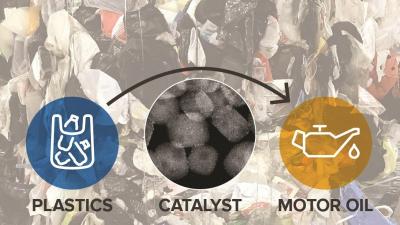A multi-institutional team of scientists has designed a new catalytic method in order to battle plastic pollution on a global scale. The team's new catalytic method could prove useful for selectively converting discarded plastics into higher quality products.

"We asked ourselves the question, â'Plastic, plastic everywhere: What can we do about it in terms of chemical recycling?'' said Max Delferro, group leader of the Catalysis Science Program in the Chemical Sciences and Engineering division at the U.S. Department of Energy's (DOE's) Argonne National Laboratory. â'So, we assembled a talented team with DOE's Ames Laboratory and researchers from top universities to provide a solution.' The partners from academia included Northwestern University, Cornell University, University of South Carolina and University of California, Santa Barbara".
Experts suggest that while some of the waste plastic can be recycled, the product obtained is usually of lower quality and less value than original polymer. The team of scientists has therefore developed a catalytic method for converting discarded plastics into products of higher quality such as waxes and lubricant oil. The waxes can further be processed into daily-use products such as cosmetics and detergents.
Plastics such as polythene cannot be degraded easily due to strong carbon-carbon bonds. The catalyst contains platinum nanoparticles, each of which is two nanometers in size. It is held in place on perovskite nanocuboids which are about hundred nanometers in size. Experts explain that perovskite is stable under demanding temperatures and pressures are necessary for catalysis. The material is hence proven to be especially good for energy conservation.
For the difficult task of depositing nanoparticles of one material on larger nanoparticles of another material, the team opted for an atomic layer deposition approach for catalyst development, a technique developed at Argonne and Northwestern that allows precise control of nanoparticle size.
To test the catalyst, the authors began with a research-grade polyethylene, the most common component in plastic. Under the appropriate reaction conditions, the catalyst converted the polyethylene into a high-quality liquid product in high yield. Next, they tested the catalyst with a commercial plastic bag. Remarkably, the catalyst was just as effective with the plastic bag as pure polyethylene, and it produced far less of the light hydrocarbons (methane, ethane, etc.) generated by pyrolysis ' a process that involves heating at high temperatures' or use of a conventional catalyst consisting of platinum nanoparticles on an alumina substrate.
Upon further study in the lab, which included theoretical calculations, the team found that two main features contribute to the effectiveness of their catalyst. One is the thermal stability of the platinum nanoparticles on the larger perovskite particles, due to the close geometric match between the cubic shapes of the nanoparticles and the support. The other is the non-porosity of the perovskite material, which promotes the catalytic reaction.
'Our team is delighted to have discovered this new technology that will help us get ahead of the mounting issue of plastic waste accumulation,' said Kenneth R. Poeppelmeier, the Charles E. and Emma H. Morrison Professor of Chemistry at Northwestern's Weinberg College of Arts and Sciences, as well as director of Northwestern's Center for Catalysis and Surface Science and member of the Program on Plastics, Ecosystems and Public Health. â'Our findings have broad implications for developing a future in which we can continue to benefit from plastic materials, but do so in a way that is sustainable and less harmful to the environment and potentially human health.'
'Plastic pollution is obviously a big problem,' Delferro added. â'No one wants to go on vacation at the beach only to find plastics strewn about everywhere. While our catalyst still needs further development, our results look very promising for contributing to the national laboratories' mission of solving some of the world's most complex problems.'